Twitter-Based Safety Confirmation System for Disaster Situations
Abstract
1. Introduction
- Victims should use the hashtag #救助 (meaning #Rescue) and describe accurate and detailed information, such as the requirements, pictures, address, and location on the tweet.
- When rescued, victims should report that they have been rescued and should immediately remove the rescue-request tweet that was previously posted.
2. Related Studies and Services
2.1. Safety Confirmation Services in Disaster Situations
2.2. Rescue Request Tweets Posted during Large-scale Disasters in Japan
2.3. Facilitation of Sharing Disaster-related Information
3. Proposed Application T-@npi
3.1. Requirements
- Social media adoption: The safety information of victims should be confirmed as quickly as possible after a disaster. The proposed system requires the use of social media such as Twitter for efficient information sharing.
- Facilitation of sending rescue requests: Victims needing to be rescued must provide detailed information and the coordinates of their location on a tweet, as instructed by @TwitterLifeline [19]. However, even people who are familiar with smartphones or similar devices and social media cannot easily provide such detailed information. Thus, the proposed system must be equipped with a function that sends rescue requests via an easy operation.
- Renewal and deletion of old information: As instructed in [19], users who sent a rescue request should remove the rescue-request tweet after the rescue, and then update their status (rescue or self-resolution of the emergency). To prevent the spreading of old information, the proposed system requires a reregistration function by which users can delete the previously posted rescue request and post the new information.
- Encouraging mutual and public help: Self-help, mutual help, and public help are important for disaster prevention and mitigation. The existing services can share a user’s safety information with families, relatives, and friends (i.e., self-help), but lack functions for sending and sharing rescue requests by victims in trouble (i.e., mutual and public help). To facilitate rescue and support activities, the safety information and rescue requests should be shared with local governments and rescue experts (enabling public help), and with neighbors of the victims. The needs of a large-scale disaster may exceed the capacity of local governments, firefighter rescue parties, and police officers, necessitating the assistance of neighbors (i.e., mutual help.) Thus, the proposed system must support both mutual and public help.
- GIS integration: The registered safety information and rescue requests must be mapped on an online map for decision making decisions by local governments and rescue experts.
3.2. Twitter Adoption
- Twitter is a widely used service. Consequently, most users are conversant with it, and thus, they can use the proposed application easily. Moreover, since users do not often use existing services such as 171 and web171, they are not familiar with using them, and this has been a bottleneck in regard to the acceptance of these applications. The application proposed in this paper addresses this problem.
- Although Twitter has been previously used for rescue requests and other information sharing, rescue requests are not supported by the existing services such as 171 and web171. Therefore, these services are limited to the communication of safety information only. The proposed system overcomes this limitation.
- The proposed system is inexpensive. As information is exchanged only on Twitter, the proposed system requires no large-scale hardware.
- The system administrators and operators do not need to maintain their individual information because all users are uniquely identified by their respective Twitter IDs.
- Unlike Facebook and LINE, Twitter is an open social media, meaning that the proposed application supports mutual and public help.
3.3. Assumed Users and Devices
- Sending user: A user who posts his or her safety information.
- Confirming user: A user who checks the safety information post of another individual. The confirming user is expected to “follow” the sending user on Twitter.
- Supporting user: A user such as a local government staff member who checks the safety information of a disaster-stricken area.User devices are assumed to be smartphones, tablet PCs, or general PCs.
3.4. System Outline
3.5. System Operation and Screens
3.5.1. Index Page
3.5.2. Registration of Safety Information
- Selection of rescue request (item (1) in Figure 4): The rescue-request item offers two options, “YES” (a rescue is needed) or “NO” (no rescue is needed). If the sender selects “YES,” the tweet to be posted includes the hashtag #救助 (#Rescue). If the user selects “NO,” the tweet to be posted includes “Rescue is not needed”.
- Additional comment (item (3) in Figure 4): The sending user can enter a comment of up to 40 characters.
- Current location of the user (item (4) in Figure 4): The location information (latitude and longitude information) of the sending user is obtained by global positioning and geolocation systems and is called by JavaScript. This information is transformed into an address by a reverse geocoding service [46]. In the current version of the proposed system, address transformation is available only in Japan. When a user selects the “はい (Yes)” button for the query “現在地も合わせて送信しますか (Do you send your current location information together?),” the user’s address is sent together with the safety information. Otherwise, the address is registered as “N/A.” If the sending user’s device cannot detect the location or the user does not want to provide the location information, the address is also registered as “N/A”.
3.5.3. Reregistration of Safety Information
3.5.4. Confirmation of Safety Information
3.5.5. List and Map view for Supporting Users
3.6. Operational Test for Registration of Safety Information
- It would be useful if I could check people who have found my information. (IT)
- The web application (accessed by web browsers) is time-consuming compared with a native application. This should be improved. (IT)
- To popularize the system, the application should collaborate with other popular applications used in ordinary times. (BA)
- The system should additionally collaborate with SNSs other than Twitter. (BA)
- The application may be abused because we can post anonymously. (BA)
4. Conclusions
Author Contributions
Funding
Conflicts of Interest
References
- Imran, M.; Diaz, F.; Vieweg, S. Processing social media messages in mass emergency: A survey. ACM Comput. Surv. 2015, 47, 67. [Google Scholar] [CrossRef]
- Luna, S.; Pennock, M. Social media applications and emergency management: A literature review and research agenda. Int. J. Disaster Risk Reduct. 2018, 28, 565–577. [Google Scholar] [CrossRef]
- Zhang, C.; Fan, C.; Yao, W.; Hu, X.; Mostafavi, A. Social media for intelligent public information and warning in disasters: An interdisciplinary review. Int. J. Inf. Manag. 2019, 49, 190–207. [Google Scholar] [CrossRef]
- Andrews, S.; Day, T.; Domdouzis, K.; Hirsch, L.; Lefticaru, R.; Orphanides, C. Analyzing crowd-sourced information and social media for crisis management. In Application of Social Media in Crisis Management—Advanced Sciences and Technologies for Security Applications; Akhgar, B., Staniforth, A., Waddington, D., Eds.; Springer International Publishing AG: Cham, Switzerland, 2017; pp. 77–111. [Google Scholar] [CrossRef]
- Castillo, C. Volume: Data acquisition, storage, and retrieval. In Big Crisis Data; Cambridge University Press: Cambridge, UK, 2016; pp. 18–34. [Google Scholar] [CrossRef]
- Martínez-Rojas, M.; Pardo-Ferreira, M.; Rubio-Romero, J. Twitter as a tool for the management and analysis of emergency situations: A systematic literature review. Int. J. Inf. Manag. 2018, 43, 196–208. [Google Scholar] [CrossRef]
- Simon, T.; Goldberg, A.; Adini, B. Socializing in emergencies—A review of the use of social media in emergency situations. Int. J. Inf. Manag. 2015, 35, 609–619. [Google Scholar] [CrossRef]
- Pourebrahim, N.; Sultana, S.; Edwards, J.; Gochanour, A.; Mohanty, S. Understanding communication dynamics on Twitter during natural disasters: A case study of Hurricane Sandy. Int. J. Disaster Risk Reduct. 2019, 37, 101176. [Google Scholar] [CrossRef]
- Alam, F.; Ofli, F.; Imran, M.; Aupetit, M. A twitter tale of three hurricanes: Harvey, Irma, and Maria. In Proceedings of the 15th ISCRAM Conference, Rochester, NY, USA, 20–23 May 2018. [Google Scholar]
- Takahashi, B.; Tandoc, E.; Christine, C. Communicating on Twitter during a disaster: An analysis of tweets during Typhoon Haiyan in the Philippines. Comput. Hum. Behav. 2015, 50, 392–398. [Google Scholar] [CrossRef]
- Olteanu, A.; Castillo, C.; Diaz, F.; Vieweg, S. CrisisLex: A lexicon for collecting and filtering microblogged communications in crises. In Proceedings of the Eighth International AAAI Conference on Weblogs and Social Media (ICWSM), Ann Arbor, MI, USA, 1–4 June 2015; pp. 376–385. [Google Scholar]
- Murzintcev, N.; Cheng, C. Disaster hashtags in social media. Int. J. Geo Inf. 2017, 6, 204. [Google Scholar] [CrossRef]
- Internet White Paper. 2011. Available online: https://iwparchives.jp/files/pdf/iwp2011/iwp2011-ch01-02-p048.pdf (accessed on 15 July 2019). (in Japanese).
- News Release, Survey Research Center Co., LTD. Available online: https://www.surece.co.jp/wp_surece/wp-content/uploads/2017/08/kumamoto_press2.pdf (accessed on 15 July 2019). (in Japanese).
- Yanagida, Y. The practical use of social media at the time of disaster. J. Bus. Manag. 2012, 32, 58–67. (In Japanese) [Google Scholar]
- Doan, S.; Vo, B.K.H.; Collier, N. An analysis of Twitter messages in the 2011 Tohoku Earthquake. Electron. Healthc. 2012, 91, 58–66. [Google Scholar] [CrossRef]
- Fujishiro, H.; Matsushita, M.; Ogasawara, M. Effective use of social media in large-scale disasters: The applicability of information triage. Socio Inform. 2018, 6, 49–63. (In Japanese) [Google Scholar] [CrossRef]
- Yamada, S.; Utsu, K.; Uchida, O. An analysis of tweets posted during 2018 Western Japan heavy rain disaster. In Proceedings of the 2019 IEEE International Conference on Big Data and Smart Computing (BigComp 2019), Kyoto, Japan, 27 February–2 March 2019. [Google Scholar] [CrossRef]
- @TwitterLifeline, Twitter. Available online: https://twitter.com/TwitterLifeline/status/1016519147738419201 (accessed on 12 June 2019).
- Nishikawa, S.; Tanaka, N.; Utsu, K.; Uchida, O. Time trend analysis of “#Rescue” tweets during and after the 2017 northern Kyushu heavy rain disaster. In Proceedings of the 2018 5th International Conference on Information and Communication Technologies for Disaster Management (ICT-DM), Sendai, Japan, 4–7 December 2018. [Google Scholar] [CrossRef]
- Sato, S. Analysis of tweets hashtagged “#Rescue” in the 2017 North Kyushu heavy rain disaster in Japan. In Proceedings of the 2018 5th International Conference on Information and Communication Technologies for Disaster Management (ICT-DM), Sendai, Japan, 4–7 December 2018. [Google Scholar] [CrossRef]
- Nishikawa, S.; Uchida, O.; Utsu, K. Analysis of rescue request tweets in the 2018 Japan floods. In Proceedings of the 2019 International Conference on Information Technology and Computer Communication (ITCC 2019), Singapore, 16–18 August 2019; pp. 29–36. [Google Scholar] [CrossRef]
- Abe, M.; Uchida, O.; Utsu, K. Operability improvement of twitter-based safety confirmation system for disaster situations. In Proceedings of the 2017 International Conference on Parallel and Distributed Processing Techniques and Applications (PDPTA), Las Vegas, NV, USA, 17–20 July 2017; pp. 203–208. [Google Scholar]
- Google, Google Person Finder. Available online: https://www.google.org/personfinder/ (accessed on 22 July 2019).
- International Committee of the Red Cross (ICRC), Restoring Family Links. Available online: https://familylinks.icrc.org/en/Pages/home.aspx (accessed on 22 July 2019).
- American Red Cross, Safe and Well. Available online: https://safeandwell.communityos.org/cms/index.php (accessed on 22 July 2019).
- NTT EAST, Disaster Emergency Message Dial 171. Available online: https://www.ntt-east.co.jp/en/saigai/voice171/ (accessed on 22 July 2019).
- NTT WEST, Emergency Message Board web171. Available online: https://www.ntt-west.co.jp/dengon/web171/english/ (accessed on 22 July 2019).
- Sekiya, N.; Fukasawa, T. Why few people use information systems for confirming human safety in disaster? J. Soc. Saf. Sci. 2007, 9, 189–198. (in Japanese). [Google Scholar]
- Hatayama, M. A study on personal safety confirmation system in a time of disaster. In Proceedings of the Papers and proceedings of the Geo. Information Systems Association, Niigata, Japan, 15–16 October 2009; pp. 95–98. (In Japanese). [Google Scholar]
- Help Center, Facebook. Available online: https://www.facebook.com/help/www/516656825135759?helpref=faq_content (accessed on 12 June 2019).
- LINE. Available online: https://linecorp.com/ja/pr/news/ja/2017/1670 (accessed on 12 June 2019).
- Kropczynski, J.; Grace, R.; Coche, J.; Jalse, S.; Obeysekare, E.; Montarnal, A.; Bénaben, F.; Tapia, A. Identifying Actionable Information on Social Media for Emergency Dispatch. In Proceedings of the ISCRAM Asia Pacific 2018, Wellington, New Zealand, 5–7 November 2018. [Google Scholar]
- Grace, R.; Halse, S.; Kropczynski, J.; Tapia, A.; Fonseca, F. Integrating social media in emergency dispatch via distributed sensemaking. In Proceedings of the 16th International Conference on Information Systems for Crisis Response And Management (ISCRAM 2019), Valencia, Spain, 19–22 May 2019. [Google Scholar]
- Neubig, G.; Matsubayashi, Y.; Hagiwara, M.; Murakami, K. Safety Information Mining—What can NLP do in disaster. In Proceedings of the 5th International Joint Conference on Natural Language Processing, Chiang Mai, Thailand, 9–13 November 2011; pp. 965–973. [Google Scholar]
- Aida, S.; Shindo, Y.; Utiyama, M. Rescue activity for the great east japan earthquake based on a website that extracts rescue requests from the net. Nat. Lang. Process. 2013, 20, 405–422. (In Japanese) [Google Scholar] [CrossRef][Green Version]
- Song, C.; Fujishiro, H. Toward the automatic detection of rescue-request tweets: Analyzing the features of data verified by the press. In Proceedings of the 6th International Conference on Information and Communication Technologies for Disaster Management (ICT-DM 2019), Paris, France, 18–20 December 2019. [Google Scholar]
- Tomaszewski, B.; Judex, M.; Szarzynski, J.; Radestock, C.; Wirkus, L. Geographic information systems for disaster response: A review. J. Homel. Secur. Emerg. Manag. 2015, 12, 1–32. [Google Scholar] [CrossRef]
- Tomaszewski, B. A survey of GIS for disaster management. In Geographic Information System (GIS) for Disaster Management; CRC Press: Boca Raton, FL, USA; pp. 1–25. [CrossRef]
- Yang, J.; Yu, M.; Qin, H.; Lu, M.; Yang, C. A twitter data credibility framework—Hurricane harvey as a use case. ISPRS Int. J. Geo Inf. 2019, 8, 111. [Google Scholar] [CrossRef]
- Uchida, O.; Kosugi, M.; Endo, G.; Funayama, T.; Utsu, K.; Tajima, S.; Tomita, M.; Kajita, Y.; Yamamoto, Y. A real-time information sharing system to support self-, mutual-, and public-help in the aftermath of a disaster utilizing twitter. IEICE Trans. Fundam. 2016, E99-A, 1551–1554. [Google Scholar] [CrossRef]
- Kosugi, M.; Utsu, K.; Tajima, S.; Tomita, M.; Kajita, Y.; Yamamoto, Y.; Uchida, O. Improvement of twitter-based disaster-related information sharing system. In Proceedings of the 4th International Conference on Information and Communication Technologies for Disaster Management (ICT-DM’17), Münster, Germany, 11–13 December 2017. [Google Scholar] [CrossRef]
- Utsu, K.; Ueta, S.; Tajima, S.; Kajita, Y.; Murakami, Y.; Uchida, O. Town-watching workshop using disaster information tweeting and mapping system. Future Internet 2019, 11, 150. [Google Scholar] [CrossRef]
- Kosugi, M.; Uchida, O. Chatbot application for sharing disaster-information. In Proceedings of the 6th International Conference on Information and Communication Technologies for Disaster Management (ICT-DM 2019), Paris, France, 18–20 December 2019. [Google Scholar]
- Twitter API. Available online: https://dev.twitter.com/overview/documentation (accessed on 13 January 2020).
- Reverse Geocoding Service, National Agriculture and Food Research Organization, Japan. Available online: https://www.finds.jp/rgeocode/index.html.ja (accessed on 13 January 2020).
- Yahoo! JavaScript Map API, Yahoo! Japan. Available online: http://developer.yahoo.co.jp/webapi/map/openlocalplatform/v1/js/ (accessed on 13 January 2020).
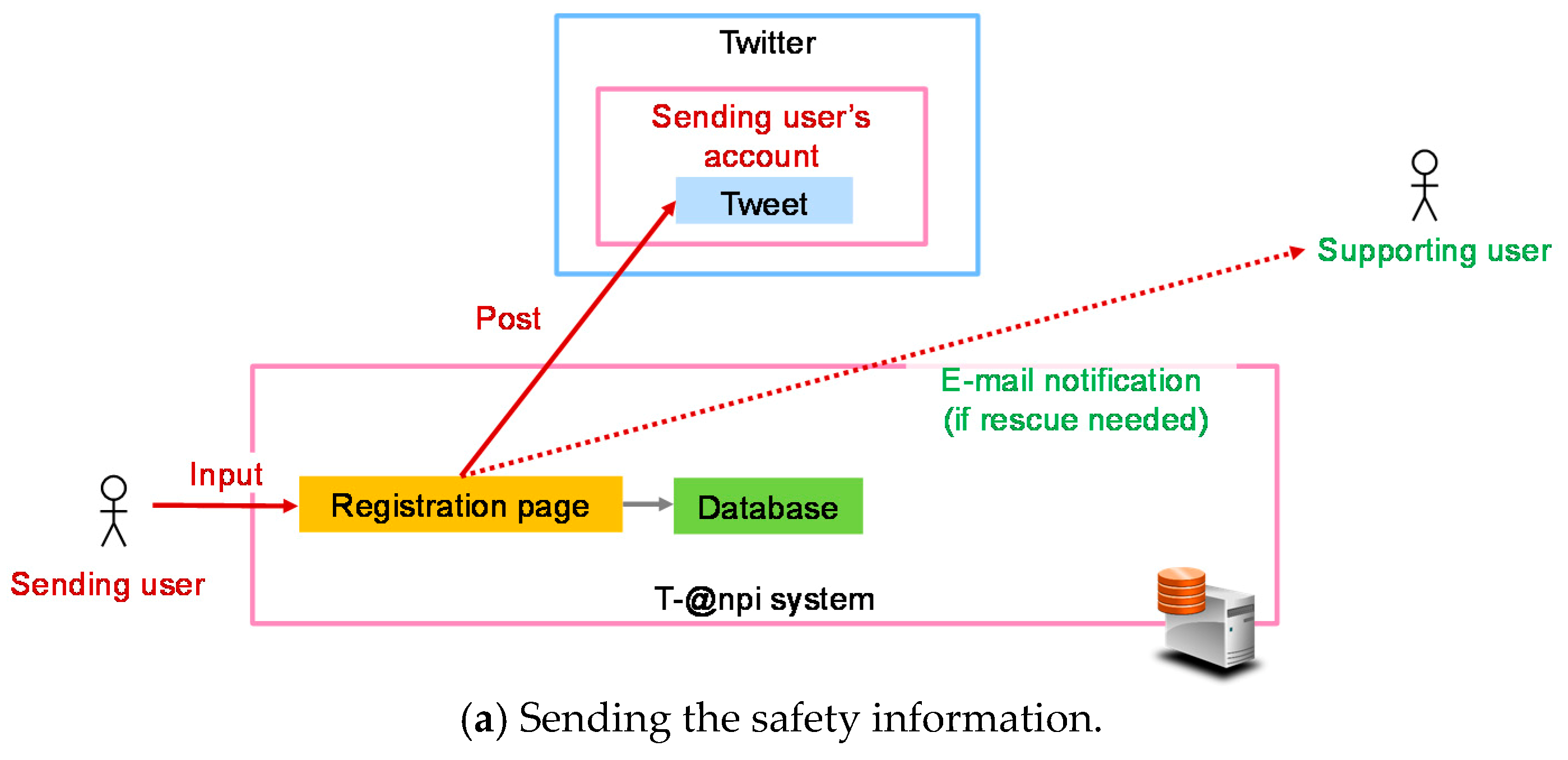
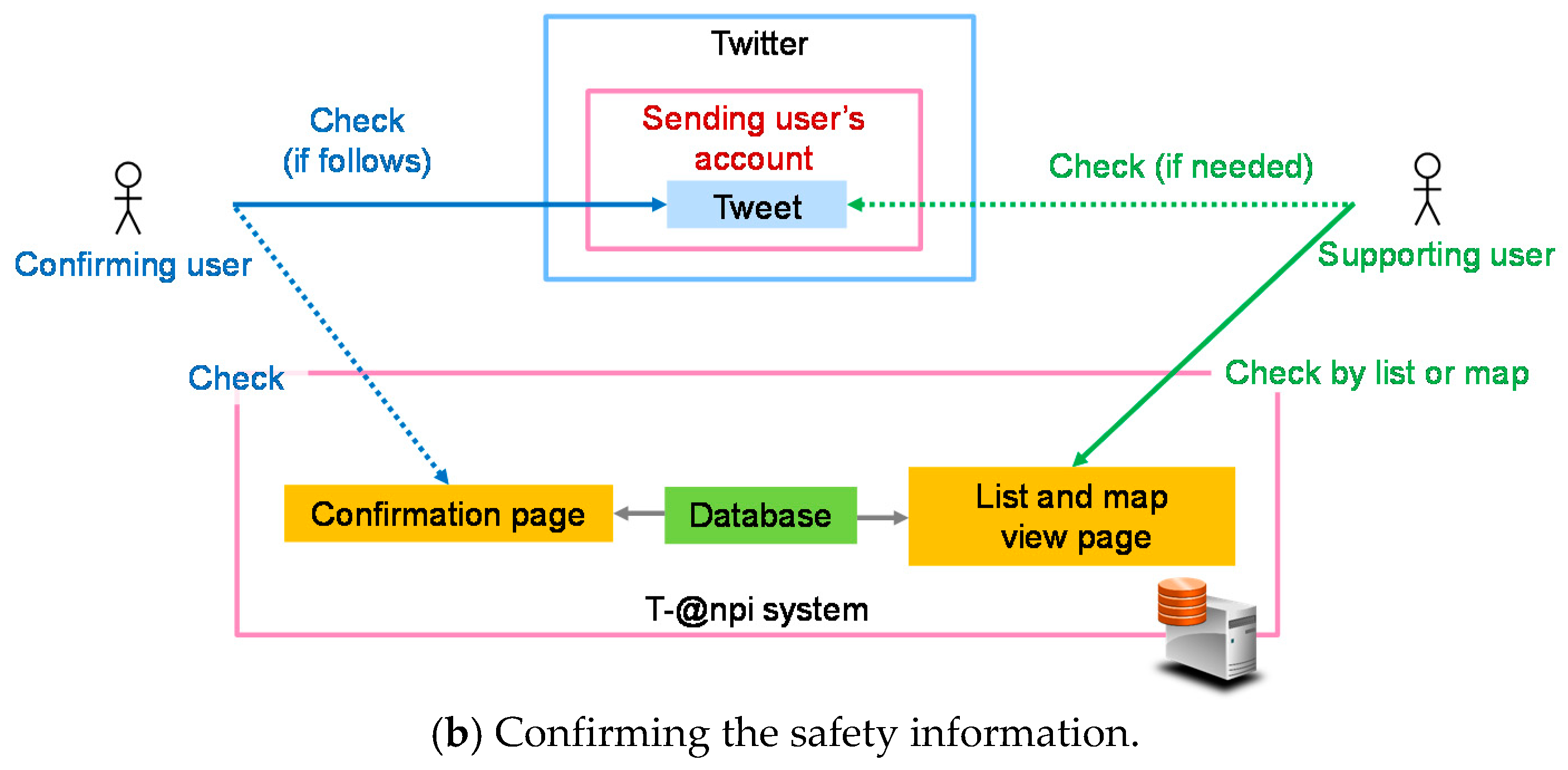
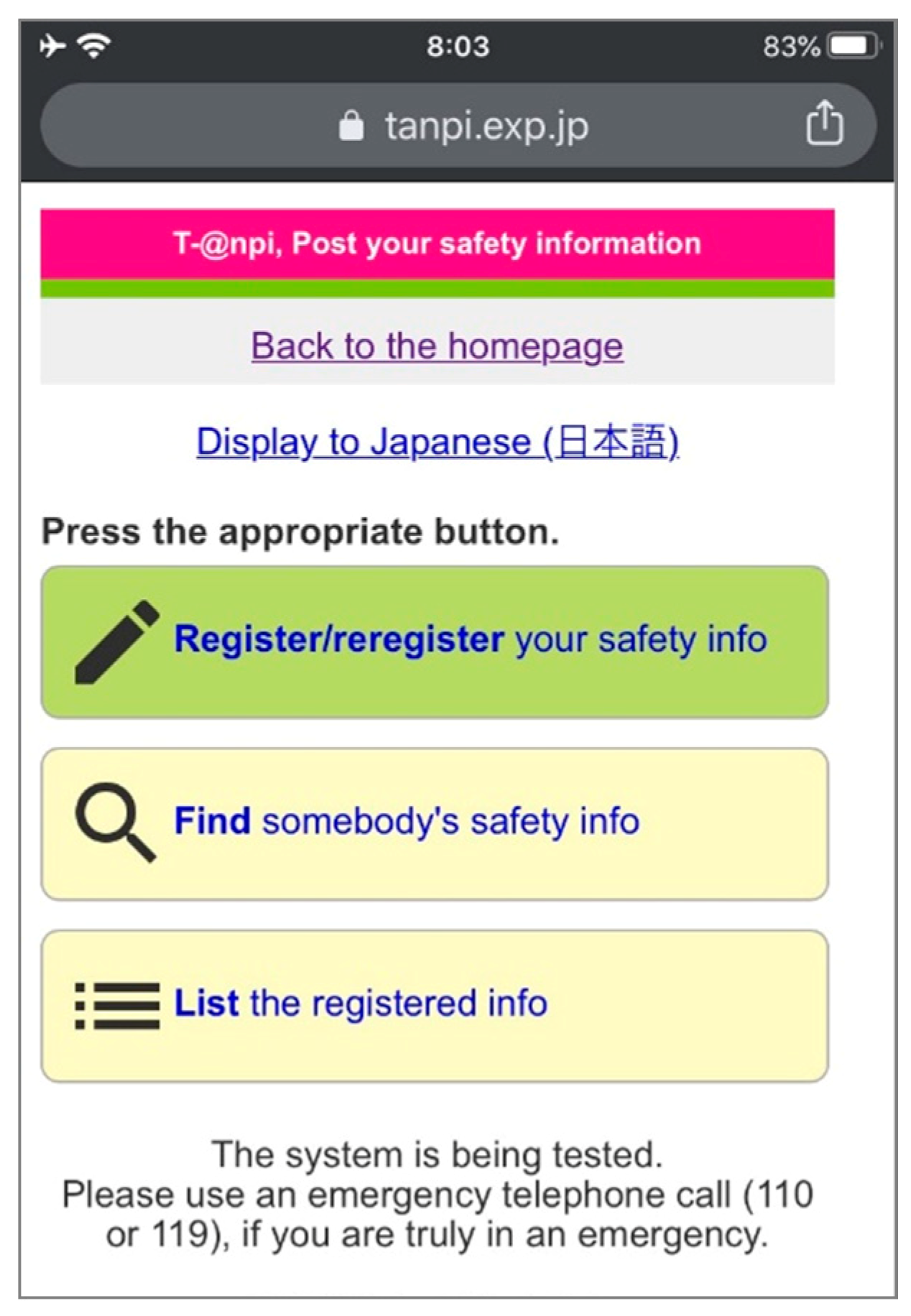
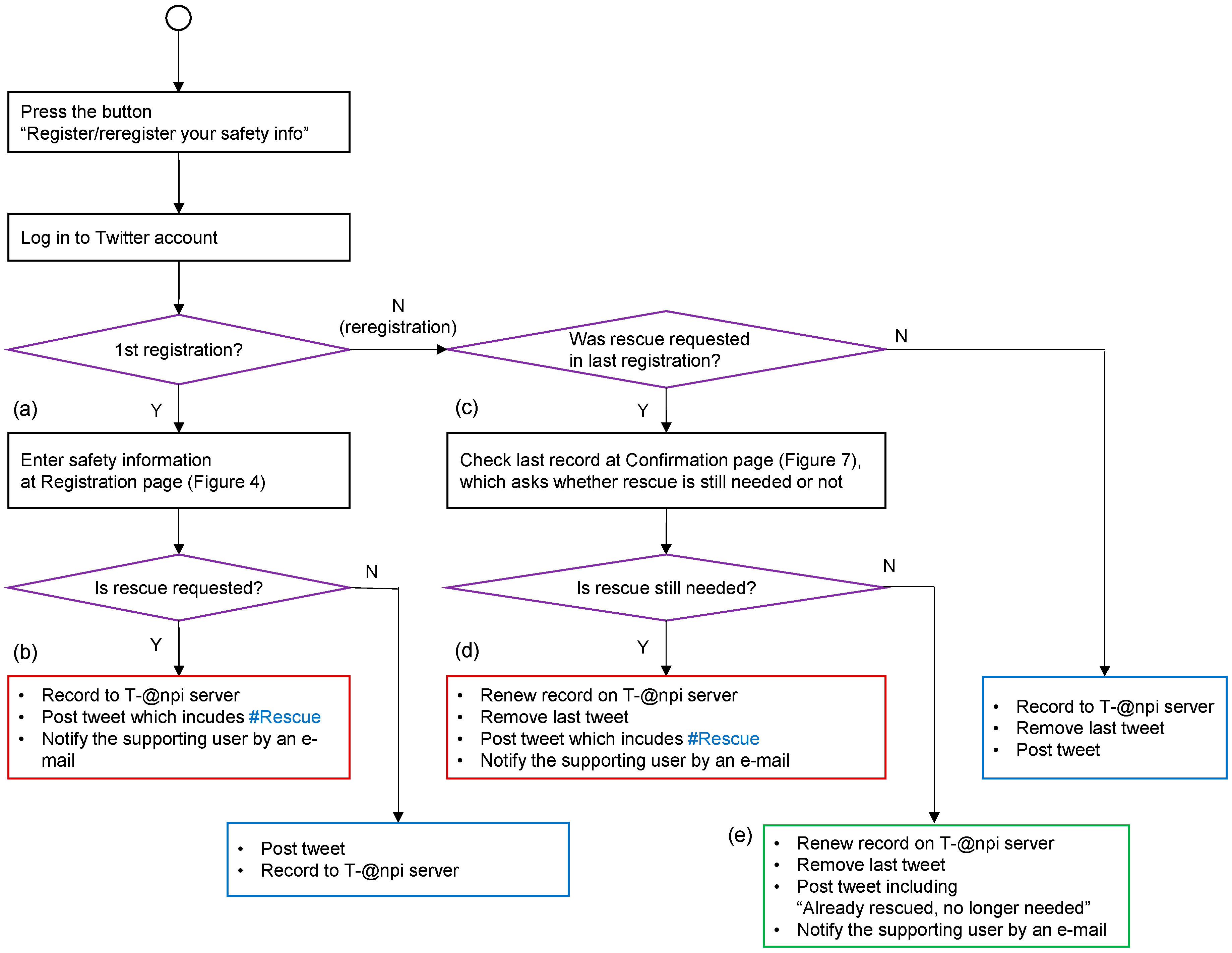



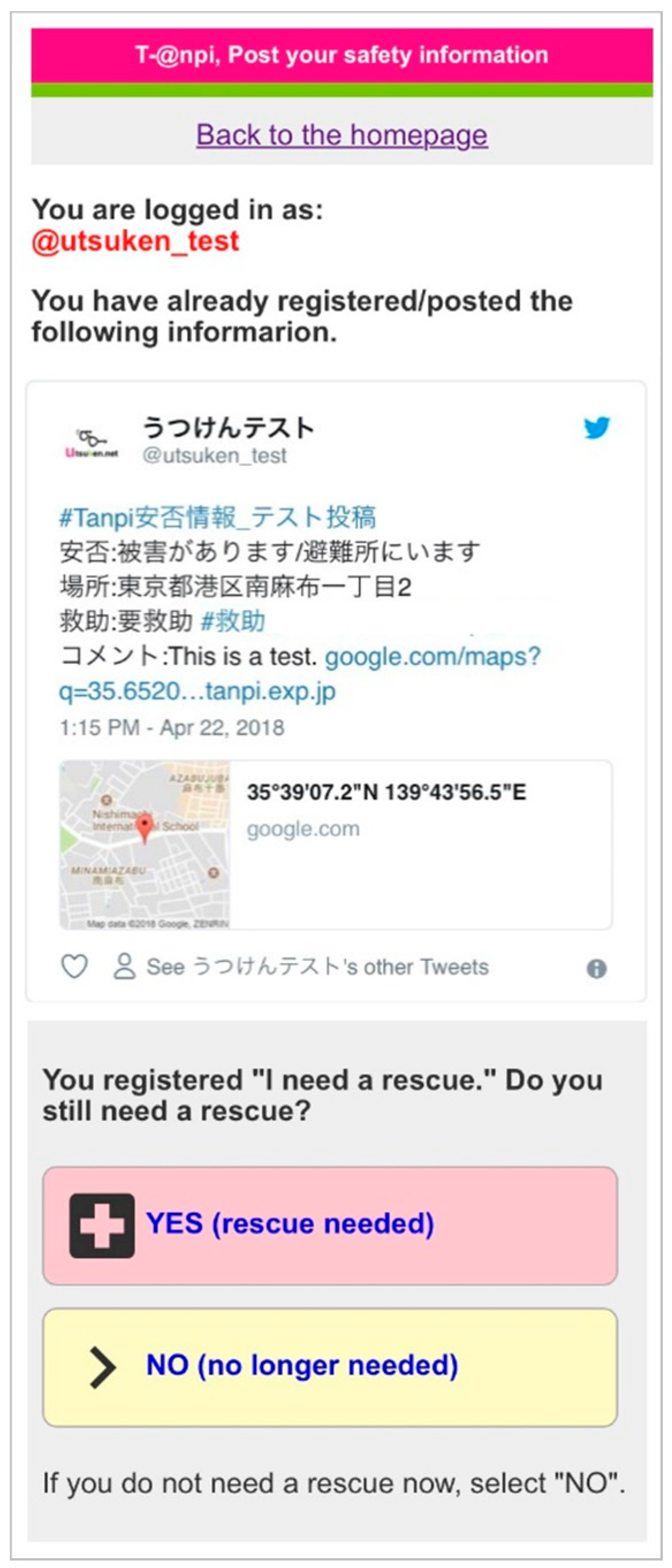

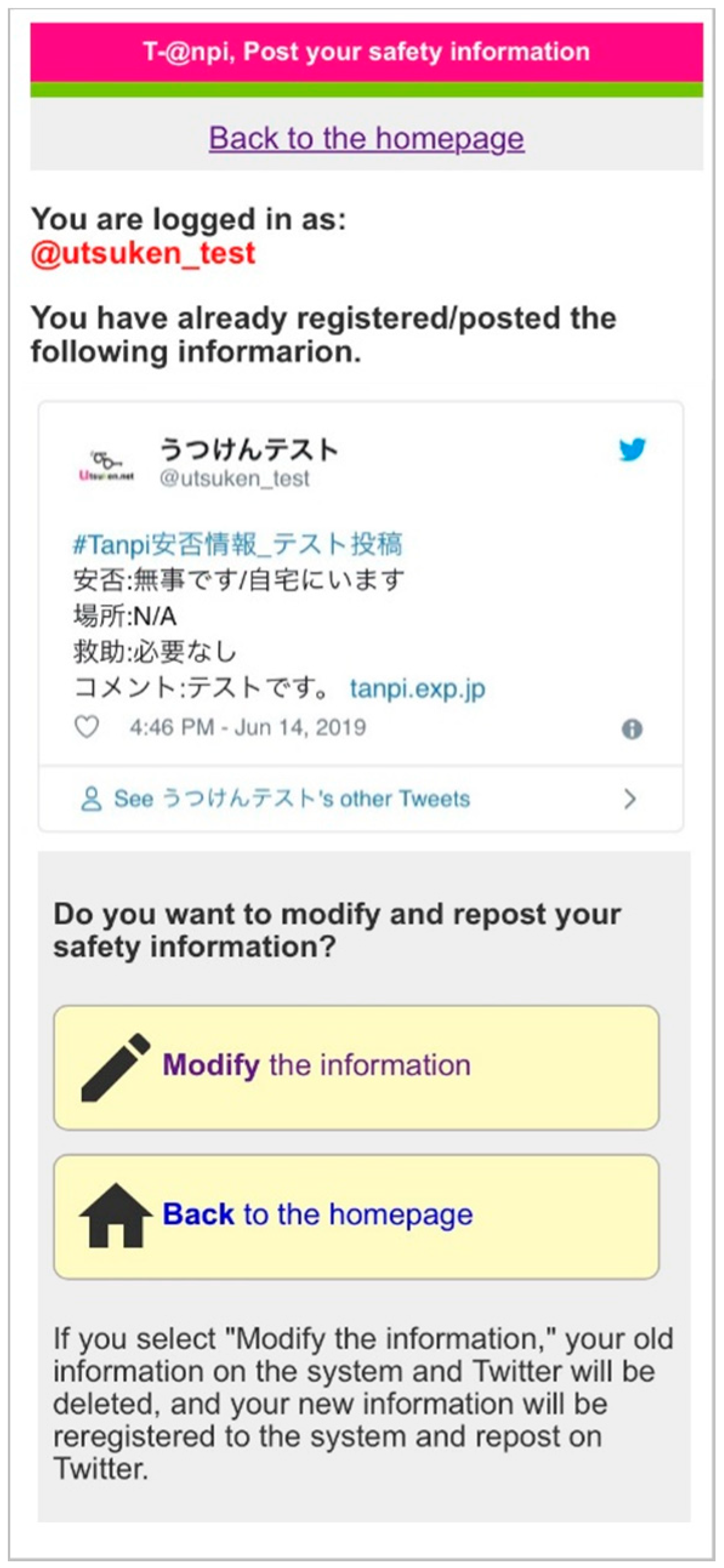
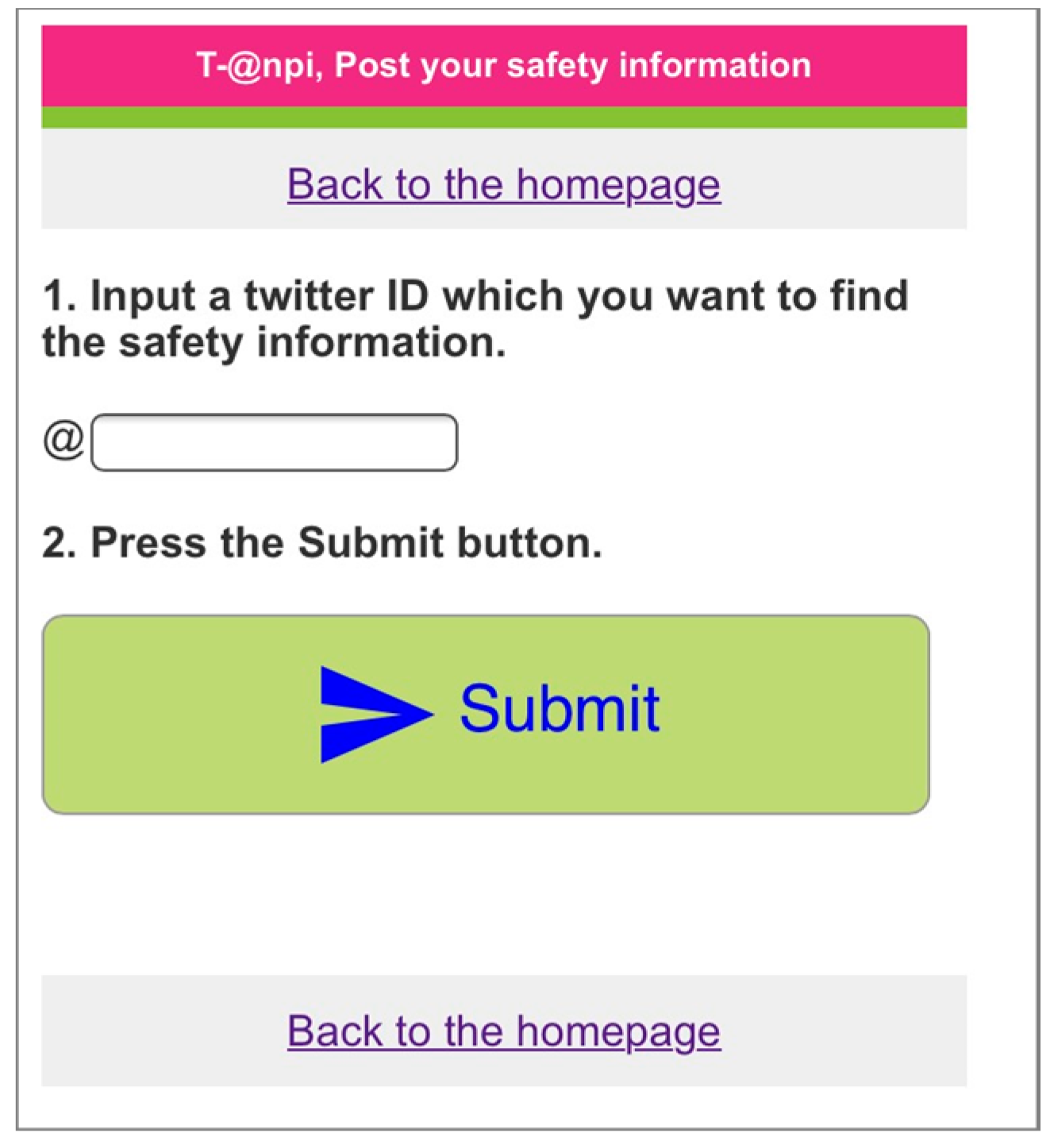
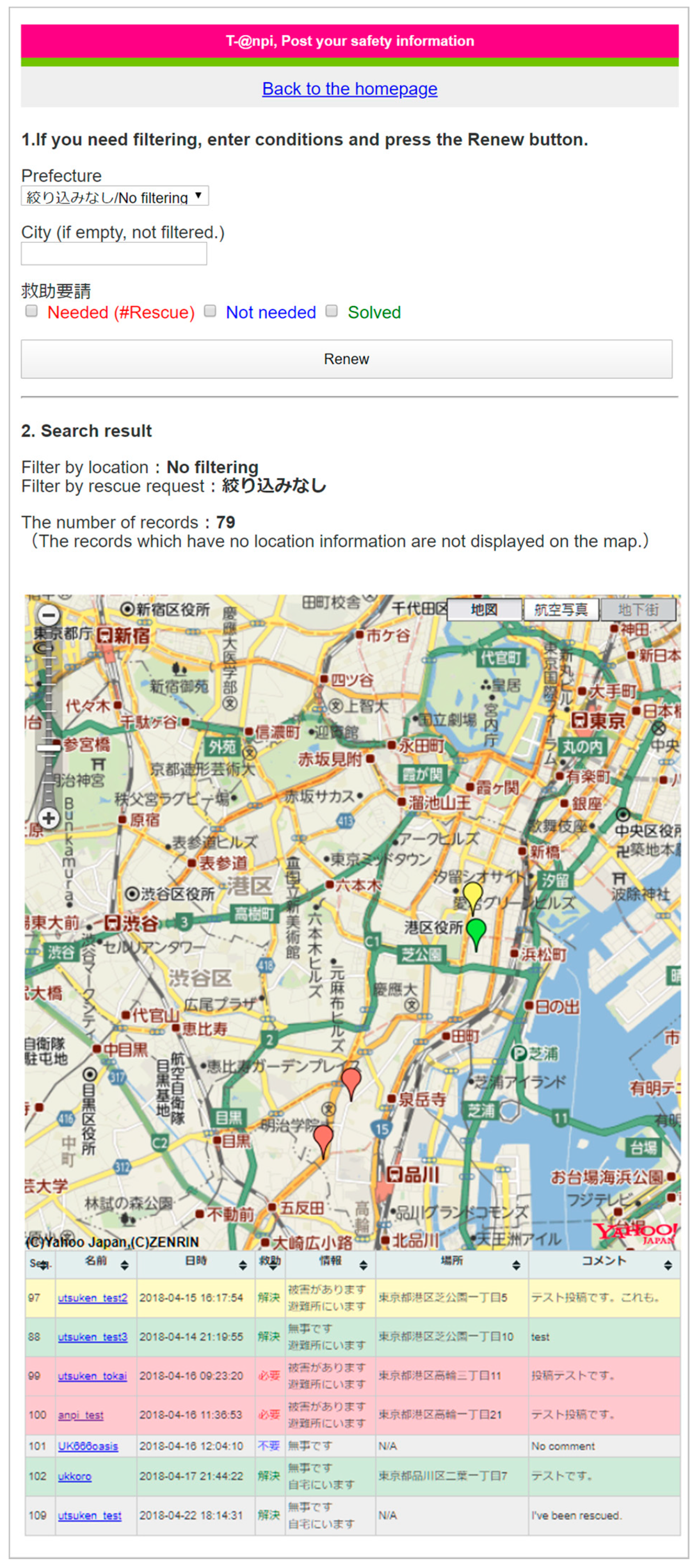
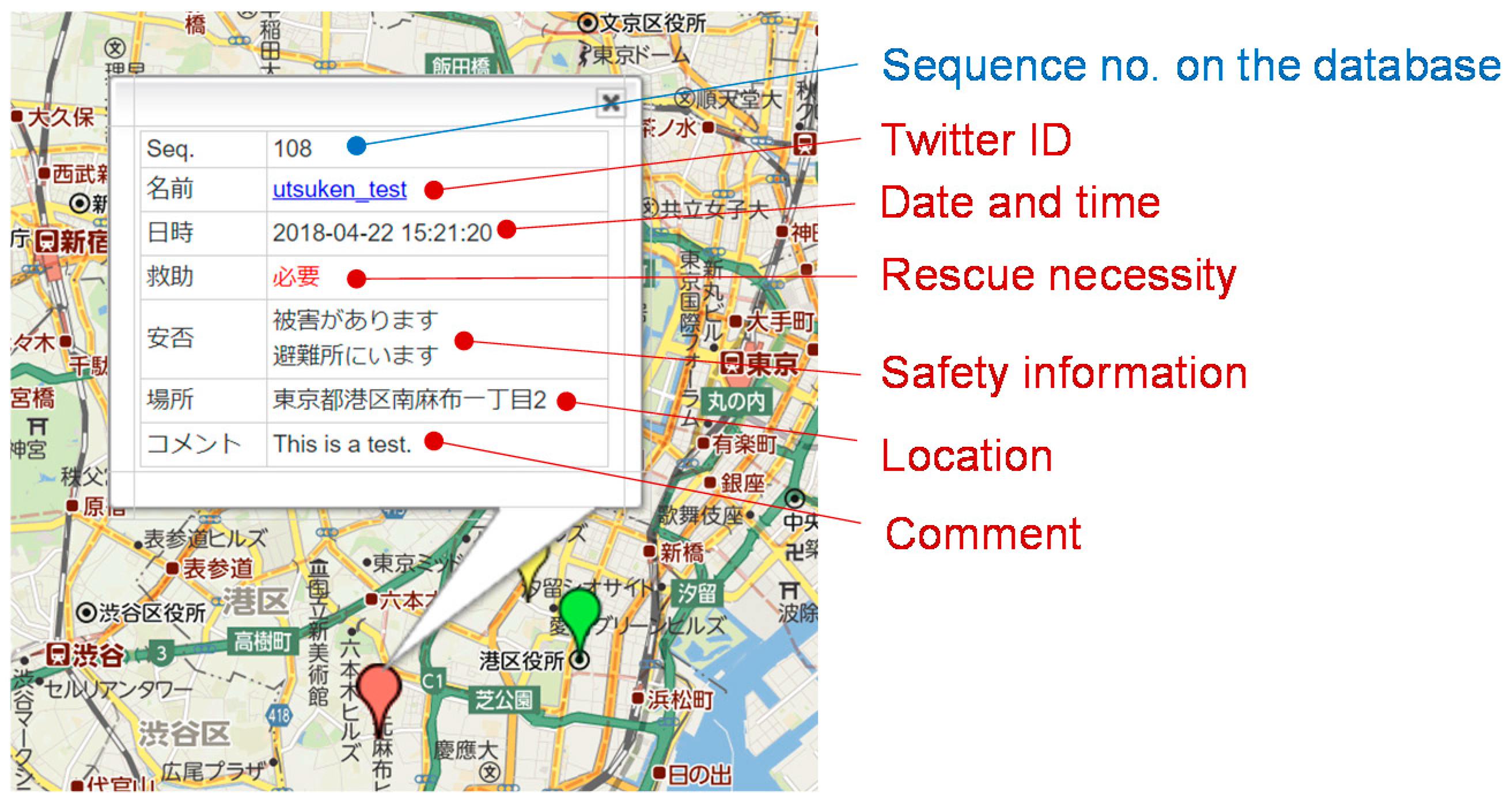
| Location Submitted | Yes | No | |||
|---|---|---|---|---|---|
| Rescue needed | Yes | No/No longer | No longer | No | Any |
| Injured/damaged checked | Any | Yes | No | No | Any |
| Background color on the table entry | |||||
| Icon on the map |  |  |  |  | Not displayed |
© 2020 by the authors. Licensee MDPI, Basel, Switzerland. This article is an open access article distributed under the terms and conditions of the Creative Commons Attribution (CC BY) license (http://creativecommons.org/licenses/by/4.0/).
Share and Cite
Utsu, K.; Abe, M.; Nishikawa, S.; Uchida, O. Twitter-Based Safety Confirmation System for Disaster Situations. Future Internet 2020, 12, 14. https://doi.org/10.3390/fi12010014
Utsu K, Abe M, Nishikawa S, Uchida O. Twitter-Based Safety Confirmation System for Disaster Situations. Future Internet. 2020; 12(1):14. https://doi.org/10.3390/fi12010014
Chicago/Turabian StyleUtsu, Keisuke, Mariko Abe, Shuji Nishikawa, and Osamu Uchida. 2020. "Twitter-Based Safety Confirmation System for Disaster Situations" Future Internet 12, no. 1: 14. https://doi.org/10.3390/fi12010014
APA StyleUtsu, K., Abe, M., Nishikawa, S., & Uchida, O. (2020). Twitter-Based Safety Confirmation System for Disaster Situations. Future Internet, 12(1), 14. https://doi.org/10.3390/fi12010014






